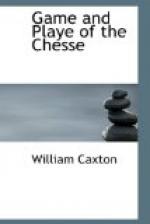The curious treatise which contains the supposed conversations of King Bocchus and the philosopher Sidrac (p. 171) was a favourite science book of the middle ages. It is probably of oriental origin, but there are editions in Latin, French, German, Flemish, Dutch, Italian, and English. By way of question and answer very decided statements are made on a wide variety of topics of which the author was profoundly ignorant. The particular part referred to by Cessoles is chap, cclxxxi: “Pourquoy sacostent les hommes charnellement aux femmes grosses et les bestes ne le font pas?"[25] John the Monk (p. 70) is the noted canonist Giovanni Andrea, who died at the plague of Bologna in 1347. His learning gained him such titles as rabbi doctorum and normaque morum. His commentaries on the decretals were frequently reprinted. He gave the name of “Novellae” to this work after the name of his mother and daughter. His code of morality contained no prohibition of literary theft, for his additions to the “Speculum Juris” of Durand are said to have been taken bodily from Oddrale. In the same magnificent manner he appropriated the treatise “De Sponsalibus et Matrimonio” of Anguissola. His daughter Novella was a learned woman, and became the wife of Giovanni Calderino, a jurist of Bologna. Their son, Gaspard Calderino, wrote a commentary on the decretals. Father, daughter, son-in-law, and grandson appear to have all been experts in the canon law.[26]
The reference to the “first book of the Truphes of the Philosophers by figure” does not convey a very definite idea as to the particular work intended. It must have been somewhat miscellaneous in character, for one extract describes the fountain of the syrens (p. 122), and the other is an anecdote, which though told here of Julius Caesar (p. 71), is really the story of the soldier who had fought at Actium with Augustus Caesar. It occurs also in the “Gesta Romanorum,” where the emperor is named Agyos.
“Helmond” (p. 33, &c.) is intended for Helinand, who died some time after 1229. After a brilliant period at the court of Philip Augustus, where he is represented as reciting his heroic verses before the king and his surrounding, he became a monk of the Cistercian Abbey of Froidmont. One of his surviving poems deals with the melancholy subject of death. The “Flores Helinandi” are said to have been popular as well as his “Chronique.” He is also the reputed author of some sermons, and of the life of St. Gereon, published by the Bollandists, and of other works still inedited. He is sometimes confounded with another French monk of the same name, who lived in the eleventh century, and was an inmate of the monastery at Persigne in Maine. This second Helinand was the author of commentaries or glosses on the Apocalypse and Exodus.[27] The first-named has been credited with the authorship of “Gesta Romanorum.” The grounds for this are very slight. “On a longtemps ignore le nom de




